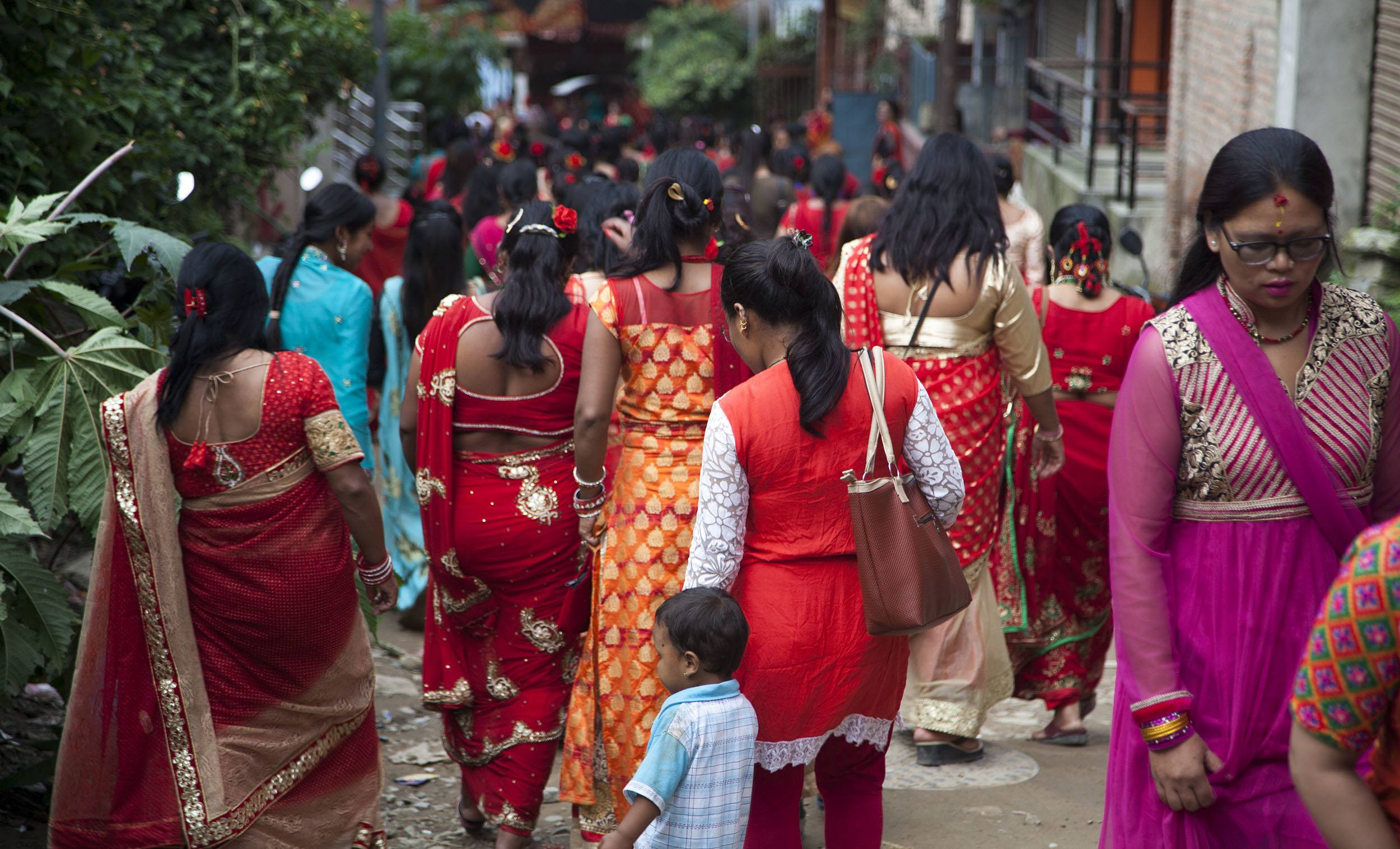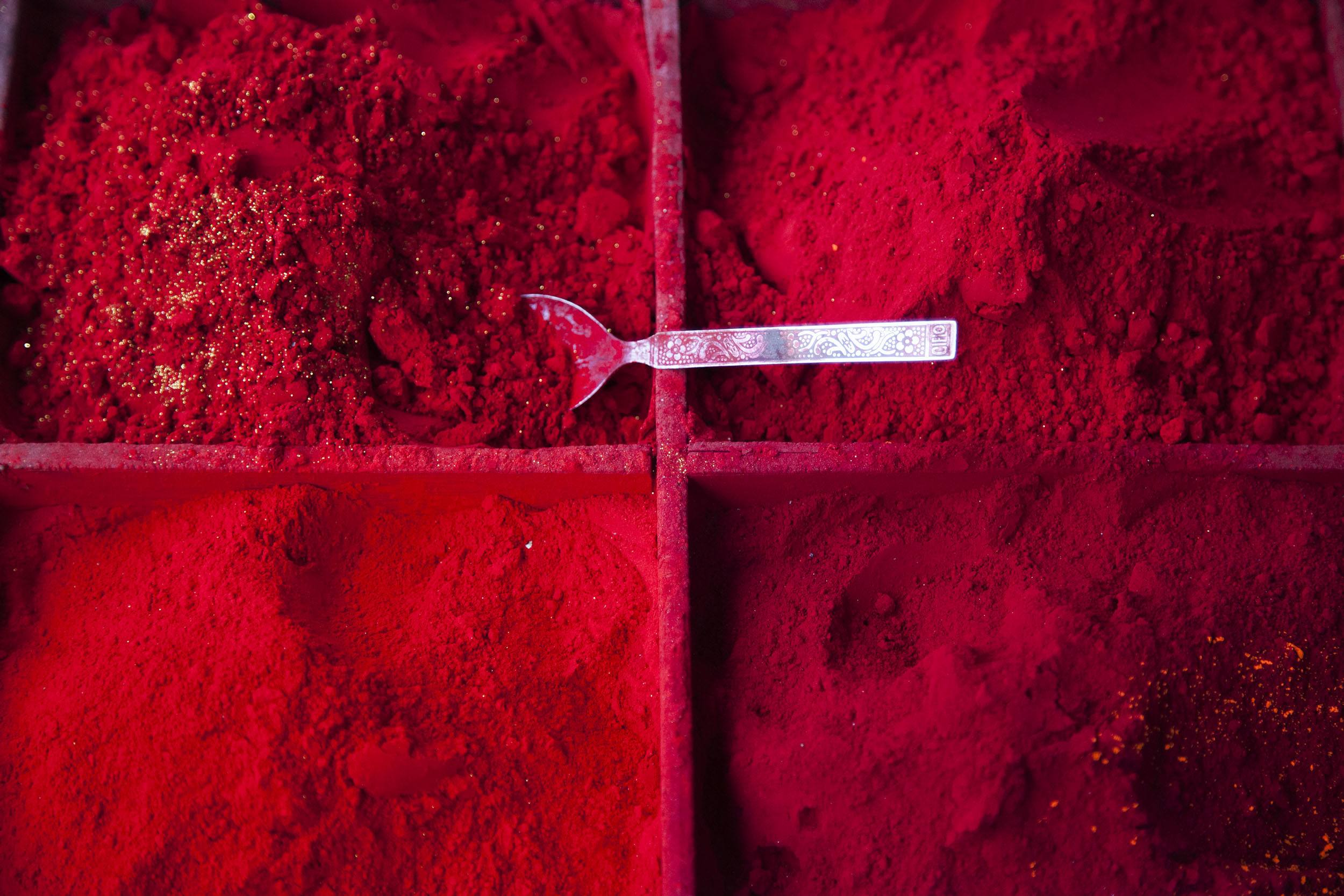I made haste — on foot — for Pashupatinath Temple, my stride quickening with every step. Ahead, women in red moved swiftly, their long strides proud, their hair adorned with shimmering jewels and intricate fabric. They bounded across the dusty road, leaving behind the city's tourist hub as the charcoal sky cracked open, allowing a sliver of golden light to pierce through.
The energy of Teej Festival in Nepal pulsed through the streets, an unbroken current of devotion and celebration drawing thousands toward the sacred temple.

Determined to reach Pashupatinath before the festival reached its peak, I pressed on — until, suddenly, the earth gave way beneath me. The muddy road, indistinguishable from the damp soil, swallowed my leg knee-deep.
Unbothered, I washed the grime away with bottled water and pressed forward, my gaze fixed on the spectacle before me. As far as I could see, women — draped in saris of every shade of red — wove through the streets, a dazzling wave of movement and colour against the grey Kathmandu sky.

Yet Teej is more than a visual feast — it is a festival steeped in devotion, where rituals of fasting, feasting, and prayer unfold over several days, each with its own significance.
But what exactly happens during Teej, and where can you experience it in Kathmandu? Here’s what I discovered.
📌 Quick Facts About Teej Festival in Nepal
- Where? Mainly in Kathmandu, Nepal, especially at Pashupatinath Temple & Durbar Square
- When? Celebrated in August or September (based on the Nepali lunar calendar)
- What Happens? Women fast, dance, and worship Goddess Parvati for marital harmony & blessings
- Best Way to Experience It? Visit Pashupatinath Temple for the most vibrant celebrations
What Is Teej Festival in Nepal, and How Is It Celebrated?
I’d been fortunate to arrive in Kathmandu, the city of dreams surrounded eternally by mountains, a week before the commencement of the nationally celebrated – and internationally recognised - Hindu Teej Festival. However, I’d not been privy to festival details until a day before its conclusion.


Fortunately, the final day was to be the biggest and most spectacular of the four-day-long celebration, the city’s streets set to flood with women in jewels, dressed in various hues of red.

I’d set out late from Thamel, camera in tow, to capture the essence of the festival and its rituals.
The Meaning Behind Teej Festiva in Nepal: Rituals and Traditions
Named after a red insect that emerges courageously from the soil throughout the scaturient monsoon season from June through August, Teej is a Nepalese Hindu festival.
It is, strictly, female only.

Local lore asserts that women fast, then feast, all ritual associated with Hindu beliefs.
The Spiritual Significance of Teej Festival in Nepal
By participating, devotees pay credence to Goddess Parvati and her association to Shiva.
Though primarily a celebration of womanhood, men are not absent from its meaning. Beyond spiritual purification, Teej is a prayer for marital harmony and long-lasting family bonds.
Save this pin for future reference!
What Happens at Temples During Teej Festival in Nepal?
As I, dressed inappropriately in black, merged with the human traffic and weaved my way through the sea of red fabric, angelic voices emerged from the crowd as dancers - hips and bodies swaying rhythmically to folk beats - ejected radiant smiles into the crowd from the pavement.


I’d been unintentionally swept into the heart of the celebration, the soul unequivocally shaking to the electricity of human energy pulsing through the crowd.

My eyes were fixed: while the smorgasbord of red bodies moved energetically towards the temple entrance, the temples of others were being decorated with bindi, the red dot worn between the eyes symbolic of the chakra - the seat of concealed wisdom.


So many were the women in the street that I was barely able to see the sodden earth upon which our variegated sandals were pounding.
Rituals and Symbolism at Pashupatinath Temple
Once inside, they moved in multiple directions: some kneeled before Hindu statues then prostrated themselves in veneration of deities, others sat amid tranquil surroundings to meditate, while the rest performed worship by the river or simply danced uninhibitedly among friends.

Though unfamiliar with Hindu ritualistic worship, I felt the spiritual essence of Teej in the way the women moved, cared for one another, and honoured their traditions. The festival was a testament to the power of faith and communal harmony.
A Celebration of Community and Faith
Mothers helped sisters who assisted grandmothers, older women unable to support themselves.


Nieces carried baby girls as mothers busily attended to aunties who were paying to have everyone’s hands decorated.
Save this article for future reference!
A Solemn Moment: Cremation Rituals by the River
After a dead body (covered illustriously in orange fabric) had been ceremoniously cleaned in the river and cremated - surrounded by family and friends - on a pyre, I retreated from the temple and weaved my way home along dirt roads through Kathmandu’s myriad of concrete buildings.

As the rain pounded on my poncho-covered head, a sense of warmth washed through me: the red blood pulsing through my arteries and veins, although life-sustaining, could never induce a comparable multi-sensorial pleasure the red sari-dynamism of Teej had in my beating heart and soul.
Where to See and Experience Teej Festival in Nepal, in Kathmandu?
According to locals to whom I spoke regarding Teej, the two most prominent sites at which to holistically experience the annual celebration are:
- Pashupatinath Temple, and
- Kathmandu Durbar Square, the former royal palace.
Things to Consider Before Attending Teej Festival in Nepal
Are you interested in witnessing Kathmandu’s streets explode into a palette of red? If so, then consider the following points:
- The festival is celebrated on a different date each year (usually in August or September), nominated accordingly by the Nepali lunar calendar. Check this website for further information.
- As Teej usually occurs during or at the end of monsoon, appropriate attire – if visiting – will be required. Footwear, in particular, should be given particular attention as most roads within Kathmandu are dirt, which quickly deteriorate into mud with a little downpour.
- It is appropriate for men to attend the celebration, as observers. I did not see local Hindu men participating in festivities, aside from those painting the bindi on women’s heads.


- I personally avoid taking photographs, mostly, without first asking permission. The same rule applies at Teej. Although Nepalese women are softly-spoken and at times passive and shy, making it easy to ‘take advantage’ of an ideal photographic opportunity, I made a point of asking their permission before sticking my lens in their elaborately decorated faces. It wasn’t always possible, as the crowd was dense and I often inadvertently caught multiple faces, but I tried to be courteous.


- Remember to wear appropriate attire if you plan to enter the temple grounds. Bare shoulders and shorts above the knee are generally not considered acceptable.
Essential Information for Visiting Kathmandu
Here are a few things you might need to know before visiting the capital of the Himalayas.
How to Get to Kathmandu
Kathmandu is well-connected internationally and domestically, with most travellers arriving by air, though overland routes by bus are also an option.
▶ By Air
The main point of entry into Nepal is Tribhuvan International Airport. There are flights to Kathmandu from various points around Asia, including Thailand, Malaysia, Hong Kong and the United Arab Emirates. Currently, as at 2019, the only direct flight from Europe is with Turkish Airlines from Istanbul.
▶ By Bus
There are a few border crossings open to tourists, which are listed (below) in the section entitled 'Getting into Kathmandu (Nepal) - VISAS'. Most of them can be traversed using bus services. A few connections might be required, depending on your point of origin.
How to Get Around Kathmandu
Navigating Kathmandu can be an adventure in itself, with options ranging from walking through its bustling streets to hopping on a rickshaw or taxi for longer distances.
▶ On Foot
Kathmandu is much larger than I had anticipated. The air is also full of pollutants, which can aggravate and upset your airways. If you're staying centrally (in Thamel, for example) and wish only to see the key sights, then moving on foot will be fine. Otherwise, you'll need to utilise a combination of walking, bus and rickshaw or taxi.
▶ By Bus
There are bus services that cover almost the entire city (except for the centre - Thamel), including to the reaches of Patan. There are green and blue buses that run loops around the Ring Road. Knowing which bus to take can be a challenge, but locals are very helpful, so just ask at a bus stop and you'll be directed to the right bus.
Here are a few things to note:
- There's a cashier on every bus who collects fares
- The cashier (or attendant) will tell you where the bus stops and can alert you when your stop is coming up
- Buses are old and not very comfortable - it's a very authentic experience
- Carry small change as the fares are typically only 20 to 30 rupees
▶ By Taxi/Rickshaw
You'll be hard pressed to avoid being harangued by a rickshaw driver if you're walking through Thamel. Taxis, too, can be found everywhere, particularly in the touristy areas. Negotiate hard (for the rickshaw journeys) and ensure the taxi drivers use the meter, otherwise you'll end up paying double or even triple. You'll likely end up paying double anyway, unless you're an expect negotiator. Here are a few things to consider:
- tipping is considered courteous (usually one third of the fare)
- prices are always higher after dark
- taxis usually park near main streets/roads
- some taxi meters can be fixed, so if you're unsure how much a fare is likely to cost, check with a local before starting a negotiation with a taxi driver
Visas for Visiting Nepal
Aside from Indian citizens who do not need a visa to enter Nepal, almost all other nationalities (aside from a few) can get a visa on arrival, at various land borders and the international airport in Kathmandu.
Visas can be obtained for the following periods of time:
- 15 days
- 30 days
- 90 days
For specific details about what you'll need in order to get a visa on arrival, how much it's going to cost and which nationalities are not eligible, see the Nepal Immigration official website.
Currently, you can get visas at the following points of entry:
- Tribhuvan International Airport, Kathmandu
- Kakarvitta, Jhapa (Eastern Nepal)
- Birgunj, Parsa (Central Nepal)
- Kodari, Sindhupalchowk (Northern Border)
- Belahia, Bhairahawa (Rupandehi, Western Nepal)
- Jamunaha, Nepalgunj (Banke, Mid Western Nepal)
- Mohana, Dhangadhi (Kailali, Far Western Nepal)
- Gadda Chauki, Bhimdattanagar (Kanchanpur, Far Western Nepal)
Please see the website above as things do change frequently.
Where to Stay in Kathmandu
Kathmandu offers a range of accommodations, from budget-friendly guesthouses to boutique hotels nestled in the heart of the city. Whether you're looking for a lively stay in Thamel or a quieter retreat, options are plentiful.
For detailed recommendations, check out my Nepal itinerary.
Conclusion: Attending Teej Festival in Nepal
Teej Festival in Nepal is a deeply spiritual celebration of devotion, resilience, and community. From the rhythmic sways of sari-clad women in the streets to the solemn rituals at Pashupatinath Temple, the festival embodies faith in motion. Experiencing Teej firsthand is to witness Kathmandu at its most vibrant, where tradition and festivity intertwine in a sea of red.
Teej is more than a festival — it’s a living tradition, pulsing with devotion, dance, and deep-rooted faith. Whether you observe from the sidelines or find yourself swaying to its rhythms, Teej is an experience that lingers long after the last sari disappears into the Kathmandu night.
